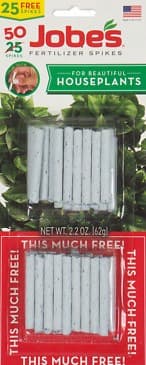How to Fertilize Houseplants

About Fertilizing Houseplants
Like outdoor plants, your indoor plants need nutrients, too. But, indoor plants need them in a much different way. The best indoor fertilizer is one that releases nutrients slowly into the soil. Ideally, indoor plants are most often grown slowly. The pots contain a limited amount of nutrients. And over time, the plants use those nutrients up. Specifically formulated houseplant fertilizers replenish the soil with all of the nutrients your plants need for healthy growth. So, let’s explore what they need and how to fertilize houseplants and learn how to fertilize houseplants.
Slow growth – Indoor plants grow much more slowly than outdoor plants. Chances are, you do not want your plants growing quickly and wildly, even if they could do so indoors. So, your indoor houseplants need far less fertilizer. But, they do need some.
Pots and Containers – Moisture and nutrients available to your houseplant, are limited to what is in the soil of the pot. As long as you do not overwater your plants, the nutrients in the soil stay there while your plants slowly consume the nutrients it requires. If you fertilize too often, nutrient levels can become excessive, and harmful to your plants. Houseplant fertilizers are specifically formulated for indoor growing and offer slow release.
How and When to Fertilize Houseplants
If your plants are healthy and growing slowly, you do not need to add fertilizer….yet. As the nutrients in the pot or container begin to be depleted, you need to begin fertilizing your plants. As with outdoor plant care, the need for fertilizer will vary.
In general, fertilize houseplants once or twice a month…at most. Use a liquid fertilizer or fertilizer spikes. If your plants look like they need a quick boost, use liquid fertilizer. Easy-to-use fertilizer spikes have a slow-release formula. You may need to insert a new spike into the soil every couple of months. Follow the instructions and application rates on the package. These instructions also tell you the frequency.
After applying fertilizer, observe the health and growth of your houseplants. Adjust your fertilizer program over time, to achieve the level of growth you desire.
Liquid fertilizer can also be used for foliar feeding. The plants green p quickly. The leaves take it in and feed the plant. Usually, this is not needed for indoor plants. If you choose foliar feeding, use a diluted formula. Spread it directly onto the leaves of the plant. Or, apply carefully with a sponge or paper towel.
Related Articles
Also, people who read this article will like:
How to Grow Houseplants – Indoor plant care
Please support our site. Shop for:
- rmmatthews100@hotmail.com
- 585-721-6528
- Rochester, NY
©1999-2024 GardenersNet.Com, All Rights Reserved

